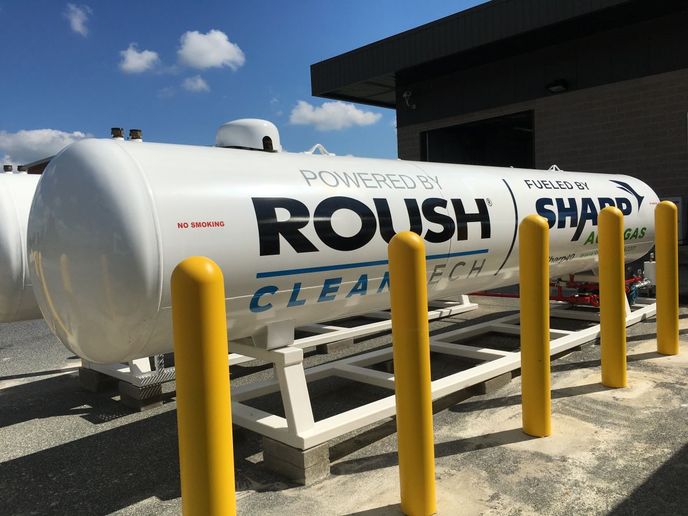Connecting Propane Fleets with the Fuel They Need
Propane autogas fueling infrastructure costs less than any other transportation energy source — conventional or alternative.
When commercial fleets look to decrease their emissions, save on budgets, and chose a sustainable fuel, many turn to propane autogas.
On average, propane autogas is up to 40% less expensive than gasoline and about 50% less than diesel. One of the additional benefits of propane is the number of fueling choices it gives the operator.
Let’s examine fueling and what you can expect from propane providers.
Propane Fueling Options
Many fleet operators choose to install onsite stations, which allows companies to install fueling infrastructure on their property, eliminating trips to off-site stations and furthering their sustainability bottom line.
Propane autogas fueling infrastructure costs less than any other transportation energy source — conventional or alternative.
A company can also opt for mobile fueling. In this scenario, the propane supplier comes to your location and fuels your vehicles onsite with a propane delivery truck.
Lastly, there are public stations. There are thousands of propane autogas fueling stations across the U.S. and stations in every state.
Also, consider America’s large surplus of propane. According to the Energy Information Administration, the U.S. had a stock of 80 million barrels in November 2017. That’s about 1.85 million barrels produced per day and exported only half.

By fueling with propane, fleets can extend the fuel’s positive impact on the environment while saving even more budget. Photo: ROUSH CleanTech
How to Find a Propane Provider
When working with fleet operators, many propane vehicle manufacturers can connect owners directly with propane providers. These are the folks who specialize in helping fleets choose the right fueling option based on fleet size, routes, budget, and facility space.
Once fleet operators complete the vehicle spec process, determine how many vehicles and the types of vehicles it needs, they are more equipped to reach out to the recommended propane marketers.
In addition to the fuel itself, propane marketers offer high-quality equipment and service.
After the supplier connects with the fleet operator, the supplier will make its recommendations. If an onsite station is selected, they will schedule a site visit with the fleet operator and the local fire marshal.
During the site visit, the three parties will walk through the location and determine where to put a fueling station. They will also discuss how many vehicles will fuel at the site, which will help calculate the expected yearly fuel usage and determine the propane tank size.

When selecting a fuel supplier, ask about their experience with propane autogas accounts. Photo: ROUSH CleanTech
What to Look for in a Propane Supplier
There are three things fleet owners should consider when selecting a propane provider.
First, they should ask about the supplier’s experience with propane autogas accounts. They should have some background in the market. If they are currently not in the autogas market, they should express interest in getting into it.
Fleets should also do their research and speak with other fleets already working with that supplier to determine what their experience has been.
Second, the supplier should be able to offer different options for acquiring the equipment. They should be able to allow fleet operators to own, lease, or lease to own.
Third, the supplier should be able to offer locked-in pricing for an extended period. Because propane autogas availability is steady, suppliers can provide fuel supply contracts to allow fleets to secure single- or multi-year pricing agreements, ensuring consistent pricing regardless of fluctuating market prices.
The U.S. is rich in propane, and using this domestic resource will help insulate fleets from the instability of foreign oil prices. By fueling with propane, fleets can extend the fuel’s positive impact on the environment while saving even more budget.
Whether a fleet operator works with its propane vehicle manufacturer or finds a propane provider themselves, be prepared for the process and know the questions to ask.
About the Author: Todd Mouw is president of ROUSH CleanTech, an industry leader of alternative fuel vehicle technology. Mouw has more than two decades of experience in the automotive and high-tech industries. He can be reached at todd.mouw@roush.com.
by Todd Mouw, ROUSH CleanTech
Source: https://www.worktruckonline.com
FLEET MANAGEMENT AUDIT
Fleet management is the use of a set of vehicles in order to provide services to a third-party, or to perform a task for our organization, in the most efficient and productive manner with a determined level of service and cost.
Fleet management activities are shown in the following graph 1:

Graph 1: fleet management activities
The proposal audit analyses and assesses all fleet management activities shown in the graph 1, and its main goals are:
- Know the overall status of the fleet management activities
- Provide the analysis, the assessment, the advice, the suggestions and the actions to take in order to cut costs and increase the efficiency and efficacy of the fleet management activities
With the information obtained, we’ll elaborate a report that holds the overall status of the fleet management as well as the suggestions, recommendations and the measures to take in order to cut costs and optimize the fleet management activities.
CLICK ON THE FOLLOWING LINK TO DOWNLOAD THE PROPOSED FLEET MANAGEMENT AUDIT:



